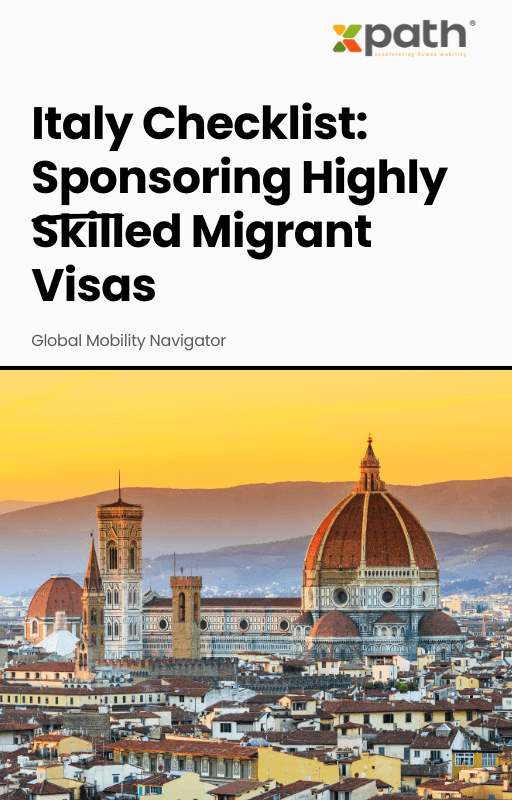Italy Checklist: Sponsoring Highly Skilled Migrant Visas
Grab a copy of a guide to international employee relocation
View E-bookThis article focuses on global telecommuting compliance. The guests discuss mostly immigration matters and risks, and it’s a sequel to a previous Nexus episode that focused on taxation and permanent establishment risks.
Compliance in all its aspects and forms, from immigration to social security and tax, became much more difficult when employees started to work remotely. During the pandemic, remote work has actually become quite the norm. However, a certain demand for remote work actually existed before the pandemic started. We expect it to continue even after the pandemic is over. Whenever that may be.
The popularity of remote working has not decreased when some of the restrictions were lifted, or some of the job markets reopened. Some of the industries returned to some level of normality. This means HR, global mobility professionals, and experts are left to deal with the intricacies of immigration, labor law, payroll, and tax compliance risks.
Jyotirmayee Chaturvedi, GENPACT:
I think what was more important was identifying those dots. Honestly, in the beginning, it was slightly overwhelming, but then we bounced back pretty quickly. At Genpact as a team, our main stage was compliance. We just wanted to be on the right side of things. So we had a multi-pronged, kind of approach which covered tracking employees, talking to their business leaders, HR leaders, to understand where employees are tracking their immigration status to see if we are compliant. Last but not least, we understood every employee’s personal situation as well. So, you know, these were those small dots, which formed part of a bigger hole.
Jyotirmayee Chaturvedi:
The challenge would be ensuring compliance. Employees are just located across the globe in different locations, and you have to be on the right side of things. So depending upon the country combination and location, you have to design a structure or you have to get them right. And the second thing which is very important as a mobility professional is the duty of care. You have to have that employee centricity at the heart of the policy solutions that you propose. With both these things in mind, we did come up with a remote work policy.
We also came up with a work-from-home policy. Honestly, no remote worker policy can be all-encompassing. Every country’s combination will have different kinds of regulations, which can be governed by the tax treaties that they have in place. They’ll always be different. As an organization, you will have to understand the level of risk that you’re willing to take. And then, I think what is all more important is change management.
You would have to educate the businesses that weren’t the kind of risks that any organization will have to face if they are non-compliant in any region. And I’m sure no organization wants to be in that space, but I think these are the two considerations. And then obviously the key consideration would be if you know that level of risk, which can cover all kinds of country combinations and then educating and change management, driving that to the organization.
UK Regulations and Exceptions
Alastair Mason, SMITH STONE WALTERS LTD: The UK’s approach to remote work is primarily focused on the physical presence and the nature of work being performed within the country. The location of employment or the source of payment is less significant compared to the actual work being done in the UK. Specific rules govern what activities are permissible on a visitor visa. For example, visitors can attend meetings, participate in conferences, and perform certain specific tasks like installing software. However, routine day-to-day work at a desk is not allowed under a visitor visa. Moreover, compensation cannot be issued by a UK entity to someone in the country on a visitor visa. Individuals attempting to enter the UK for prolonged periods, such as eight weeks under the guise of attending meetings, may face denial of entry.
US Visa Guidelines and Compliance
John Nahajzer, Maggio Kattar Nahajzer + Alexander PC: The United States adopts a similar stance regarding the physical presence of individuals performing work. The visitor status in the US is designed to facilitate business activities, allowing many to enter the country for meetings and short-term professional engagements. However, visitor status does not authorize regular employment activities.
Individuals in the US on visitor visas can engage in training or check their emails, but they cannot perform the regular duties of their job.
This distinction is critical, as there is no specific government guidance delineating these boundaries clearly. Companies and individuals must navigate these grey areas carefully to avoid violating visa conditions.
The recommendation often given is to avoid routine work activities while in the US on a visitor visa to remain compliant with the law.
Thank you Jyotirmayee, John and Alastair for your valuable inputs.
You may watch the entire interview with our 3 guests HERE.

Italy Checklist: Sponsoring Highly Skilled Migrant Visas
Grab a copy of a guide to international employee relocation
View E-book